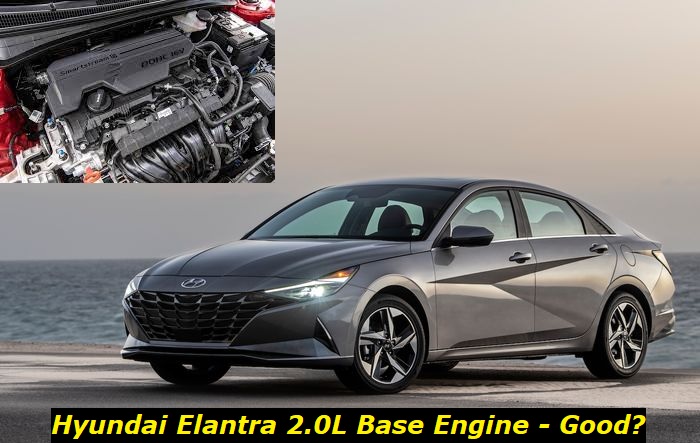Hyundai is obviously not going through the best period of its life in the US market. The Elantra is now selling about 120,000 cars a year in America while in its best years (around 2015) it sold twice more vehicles. The problem is not only with Hyundai but also with competitors. The market offers better options and better prices, also people shift from sedans to more comfortable and efficient SUVs.
Today, we'll tell you about the base 2.0L non-turbo engine in the new Hyundai Elantra and will try to understand if this engine is actually worth your money. We'll also look at gas efficiency, reliability, and other important features that will form our full understanding of the cheapest available engine in the new Elantra model.

Key facts and my opinion about the engine
- Production years: 2019-now
- Average lifespan of G4NJ/G4NL: 180,000-200,000 miles
- Fuel supply type: port injection
- Power range: 147-150 hp
- Fuel efficiency: good
- Engine block material: aluminum
- Engine reliability score: medium
- The most common problems: timing chain issues, electronic thermostat problems, rod bearings are potentially problematic, oil pump is questionable.
Some things to know about the 2.0L base engine in the new Elantra
So, the new Elantra is the seventh generation of the model that started selling in America in 2021. It looks cool and attracts some attention. In terms of powerplants, the new Elantra offers a lot: there are turbo engines, a hybrid unit, but the base and probably the most popular engine is the 2.0L non-turbocharged powerplant that we are looking at today.
This is one of the simplest engines you can find today in all new cars. The engine belongs to the Smartstream G family which is the base engine family for all gas-powered Hyundai cars. The engine is codenamed G4NL and it has been here since 2019. Although the engine is quite fresh, we already know some of its common issues and weak links.
Here's what you may want to know about this powerplant:
- it's a pretty simple engine with 2 liters of displacement, 147 horsepower, and about 142 lb-ft of torque - pretty weak for this displacement, we would say;
- the G4NJ/G4NL engine has a simple MPI injection system which is exotic now, this is good for durability and maintenance but bad for fuel consumption;
- the engine is made of aluminum, it has two injectors per cylinder making the fuel supply system almost bulletproof;
- the engine features an electronically controlled thermostat and also adjustable oil pump which can cause some concerns in high-mileage cars;
- valve timing is also adjustable (Dual CVVT), but in Smartstream G MPI engines this system doesn't cause a lot of problems, at least yet;
- the engine is mated to the CVT which spoils our mood really much - this kills all the hope for proper durability;
- the timing system is powered by a chain which is known to cause some problems at high mileage.
Even though the engine is not turbocharged and not even a direct-injection unit, it offers great fuel consumption. Hyundai claims your new Elantra with the base 2-liter engine will be able to go about 33 MPG in the city and 42 MPG on highways. This is a very optimistic claim but it turns out to be a little exaggerated. In real life, your Elantra will go about 29 MPG in the city which is still not that bad.
The engine is relatively simple and doesn't contain a lot of high-tech features. It's a good powerplant for the Elantra that is meant to be a simple family sedan for those who don't want a large Sonata but still want a good-looking Korean sedan car.
How long will the 2.0L non-turbo engine live in your Elantra?
The eventual lifespan of this engine totally depends on maintenance and care. If you don't change the oil for years and drive with lots of minor issues in this engine, it will die prematurely and may also get on your nerves a lot. But with proper care and some attention, this engine can go more than 150,000 miles. We would say even more but we are concerned with some units.
First of all, the CVT is a matter of consideration. Usually, Hyundai CVT units live no longer than 100K miles and then require replacement or repair. This may cost you too much. Also, we don't know how long the thermostat will live and whether you will locate the problem with the oil pump once it happens. If this engine overheats badly or gets poor lubrication for some time, it's dead.
Polymer coating on liners is another cause of concern. If it moves a little or gets damaged, the engine may get stuck, and repairing it will be more expensive than replacing it. You will be quite lucky if this happens within the warranty of 5 years or 60K miles. If not, you will pay for repair from your pocket.
So, we would want to say that your Elantra base engine will go more than 150,000 miles. But right now we aren't sure this is possible given all these possible issues.
What are the common problems of the 2.0L engine in the Elantra?
When buying a vehicle, you will want to investigate some of the common problems with its engine. If you have a car with a problematic engine, you will obviously regret buying it. The more miles such a vehicle puts on it, the more problems are showing up. And this may be really expensive.
Here are some of the common problems with the 2-liter non-turbo engine in the Elantra:
1. Timing chain issues
At the mileage of about 100,000 miles, the timing chain in these engines may get a little loose. This will cause rattling sounds and if nothing is done, the chain will jump. This will change the timing and eventually may cause total engine failure with cylinders hitting over valves. To avoid this, better replace the timing chain with all the accessories at 90,000 miles or so.
We would also replace the oil pump, thermostat, and water pump at this mileage. Although there are no reported issues with them right now, their failure will kill the engine.
2. Oil consumption
About half a liter of oil can be burned in 1000 miles. This is considered normal oil consumption. You will see how the amount of burnt oil grows as the mileage goes up and this is a bad sign. If your engine burns more than 1 liter of oil per every thousand miles, you should start worrying.
This usually means that the Dual CVVT is malfunctioning or there are problems with piston rings and/or valve seals. This requires very expensive repairs that you will never want to fund.
3. CVT failure
At 100K miles, your CVT may fail and will need replacement. We understand that repair shops will offer quick repair, but it will not last. In another 10,000 miles, you will be with the same problem. Replacing the CVT with a new one will cost you a fortune and you should think carefully if it's worth it with the 100,000-mile Elantra.
The new CVT will drive 100,000 more miles, but the engine will not be able to go that much. So, it's a questionable investment that may not pay off.
4. Catalytic converter issues
Although in these engines cat converter is not as close to the cylinders as in previous Smartstream engines, it still will fail earlier than you think. The first problems with catalytic converters are reported at about 60,000 miles. This means that within the life of your Elantra engine, you will have to buy two OEM catalytic converters. This is not going to cost you just a few dollars, so get ready to spend a lot.
If the converter is fully destroyed, it can still throw some ceramic dust into the cylinders and cause scratching of cylinder walls.
5. Hyundai dealers problem
We've seen many reports saying that Hyundai dealers just don't want to repair vehicles under warranty. They think of lots of excuses to not spend time and money on cars of owners that will not pay real money for repair.
Also, your Elantra may spend a couple of days or even weeks waiting for some part to arrive from Korea. This is obviously not the advantage of the Elantra.
What should you do to prolong the life of your 2.0L Elantra base engine?
It's hard to predict when one of the fatal problems with your G4NJ/G4NL engine occurs. You don't see the most problematic elements of the engine and they will fail unexpectedly. What you really need to remember is that driving your Elantra 2.0L base engine with any, even minor, fault is taboo. Don't even start the engine if you suspect something is wrong with it.
The base engine in your Elantra needs proper maintenance and here the dealer is your best friend with all those OEM oils, filters, and parts.
Also, avoid aggressive driving. This engine is certainly not made for sports. If you want more emotions from your driving, look at Elantra N or at least the Elantra N-Line with turbo engines.
About the authors
The CarAraC research team is composed of seasoned auto mechanics and automotive industry professionals, including individuals with advanced degrees and certifications in their field. Our team members boast prestigious credentials, reflecting their extensive knowledge and skills. These qualifications include: IMI: Institute of the Motor Industry, ASE-Certified Master Automobile Technicians; Coventry University, Graduate of MA in Automotive Journalism; Politecnico di Torino, Italy, MS Automotive Engineering; Ss. Cyril and Methodius University in Skopje, Mechanical University in Skopje; TOC Automotive College; DHA Suffa University, Department of Mechanical Engineering






Add comment